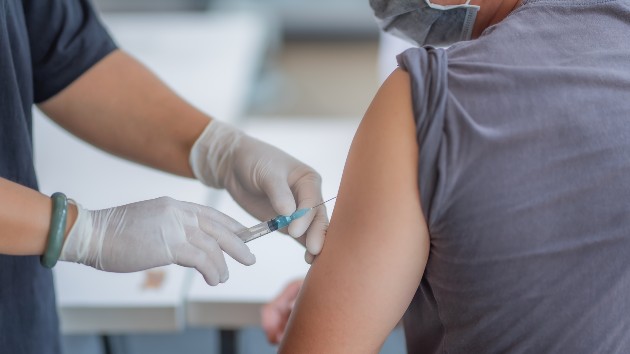
Udom Pinyo/iStock
Udom Pinyo/iStockBy MINA KAJI, ABC News
(NEW YORK) — It’s the challenge of a lifetime — getting millions of coronavirus vaccine doses quickly and safely across the country under daunting logistical conditions.
The first vaccine that may receive emergency use authorization from the Food and Drug Administration, from Pfizer and BioNTech, has to be kept at temperatures well below zero, thawed out and then administered.
And all of this will occur against the backdrop of the holiday shipping boom in an already busy shipping year. UPS says it is currently shipping 34 million packages a day — nine million more than average.
As a government advisory panel convened Thursday to decide whether to give the thumbs up to the Pfizer/BioNTech vaccine, executives from UPS and FedEx assured lawmakers that they are ready and prepared to complete one of the biggest logistics challenges in recent history — delivering 660 million COVID-19 vaccine doses nationwide, enough for the required two doses per person.
“The reason we’re both here and we’re both doing this is because we’re the only ones that can,” UPS President of Global Healthcare Wesley Wheeler said at the hearing, referring to both UPS and FedEx.
The shipping giants have collectively hired 170,000 more team members to keep up with demand. FedEx Express executive vice president and regional president of the Americas, Richard Smith, revealed they have been calling this anticipated peak “the ship-a-thon” for months.
“One of the more notable challenges will be maintaining the cold chain so that the vaccine does not experience a warmer temperature during transportation and storage than it can handle without spoilage,” said Sen. Deb Fischer, R-Neb., chair of the subcommittee on transportation and safety during the hearing Thursday.
‘Complicated’ packaging and storage
Both the Pfizer vaccine and another from Moderna are expected to be available within the next several weeks under emergency use authorizations from the FDA and they have different and very specific transit and storage requirements.
The Pfizer vaccine must be kept at minus 94 degrees Fahrenheit, while the Moderna vaccine must be maintained at minus 4 degrees. The packaging itself will play a large role in maintaining these cold temperatures in transit. For example, Pfizer’s dry ice packaging keeps the vaccine at the necessary temperature for up to 10 days.
“I’ve never seen packaging quite that complicated before, and they’ve been very proud to develop that,” Wheeler said. “I’m pretty confident that aside from real big damage that we’re going to have a lot less spoilage than you think.”
FedEx and UPS have focused on the dry ice needed for storage — expanding their network of ultra-low temperature freezers to almost 100 nationwide. UPS has even invested in dry ice manufacturing and will produce 24,000 pounds of dry ice per day in Louisville, Kentucky. The company plans to ship 40 pounds of dry ice to each Pfizer dosing location one day after the vaccine arrives.
“If we have extra dry ice and I’m sure we will,” Wheeler said, “we can provide that to independent hospitals and clinics around the world and around the country.”
Where are the vaccines going?
If authorized by the FDA, the Pfizer vaccine will be shipped to all 50 states, six major cities — Chicago, Houston, San Antonio, New York, Philadelphia and Washington, as well as eight territories. In addition, the federal Bureau of Prisons, Department of Defense, Indian Health Service and Department of Veterans Affairs will also receive it.
States had until Dec. 4 to lock in their plans on where vaccines would be shipped.
If both vaccines are authorized, there will be 40 million doses to inoculate 20 million people in December (two shots per person). At least 6.4 million doses of the Pfizer vaccine are ready to go and three million of those will be shipped out 24 hours after emergency authorization. The other three million will be shipped three weeks later and the remainder will be held as “safety stock” in the event of shipping issues.
More Pfizer vaccine will roll out every week.
Tracking and security
With such time-sensitive and life-saving cargo, tracking has also been a huge focus.
In addition to Pfizer’s own tracking system, UPS and FedEx say they will use monitoring and tracking technology of their own on each package to ensure vaccine shipments are being given the highest priority and intervene if there are any weather related or traffic delays.
FedEx and UPS pilots and drivers will be aware they are carrying vaccines, and in some cases have escorts. The U.S. Marshals confirmed to ABC News its deputies will be involved in helping to safeguard the transit of vaccine as distribution gets underway.
When vaccines are being shipped by plane, UPS and FedEx will provide the Federal Aviation Administration (FAA) a list of scheduled flights so that they can grant priority clearance.
Although U.S. carriers such as United, American and Delta have offered their assistance in transporting the vaccine, the executives said Thursday they don’t think it will be necessary for domestic deliveries.
“FedEx and UPS have split the country into two,” Wheeler explained. “We know exactly what states we have and they know what states they have.”
They are guaranteeing next-day delivery anywhere in the country by 10:30 a.m.
“We have the capability to serve every ZIP code in the United States of America,” Smith said. “This is what our network was built to do.”
Copyright © 2020, ABC Audio. All rights reserved.